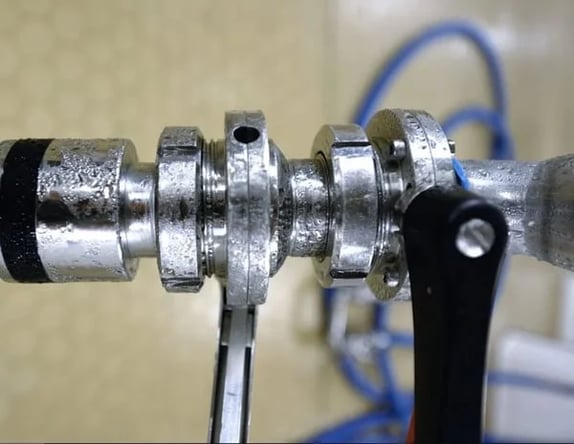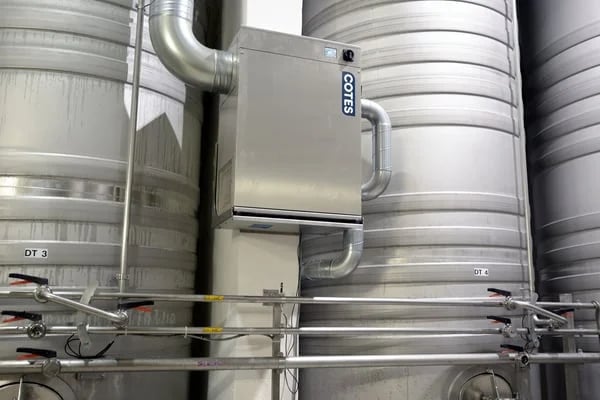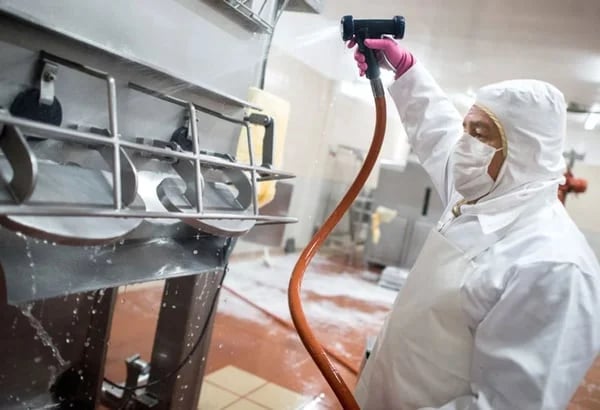Insufficient humidity management presents a critical challenge in food and beverage production, leading to spoilage, compromised equipment integrity, and detrimental effects on ingredient quality. This vulnerability can trigger mould growth, equipment malfunction, and compromised product standards, impacting both safety and overall quality assurance in the production process.
1. OVERCOMING COOLING COIL LIMITATIONS
Despite having a cooling coil in production areas, condensation issues persist, impacting drying times and quality. Cooling coils generally work better in warmer, more humid conditions as their effectiveness in extracting moisture from the air decreases the colder and drier the air gets. At 0°C ice begins to form on the cooling surfaces of condensation driers and even getting to such low temperatures requires large amounts of energy for this dry-air solution.
For food or beverage production operating in environments below 15°C or targeting a 5°C dew point, relying solely on a cooling coil can prove ineffective and cost-intensive. Cotes adsorption dehumidifiers offer an alternative, capable of achieving dew point temperatures well below 0°C in a controlled manner. This solution significantly reduces drying time, enhances energy efficiency, and upholds stringent quality standards. Exploring the functionality and advantages of this dry-air solution can provide valuable insights for optimising production processes.

2. AIR POLLUTION RISKS
Air infiltration and contamination are widespread concerns for production in colder climates as in the food and beverage industry. The former causes issues for unregulated humidity levels and increased condensation and those compromised production environments can create even bigger issues for the sanitary conditions of food and beverage production if the product is contaminated through air circulation. Both concerns cannot be avoided completely, but they can be successfully managed with an adsorption dehumidifier.
To protect the production environment and the dehumidifier itself, Cotes offer filters in various classifications and densities that can be installed to filter the air coming in and out of the machine. Additionally, each part of a dehumidifier rotor is heated up to 120°C (5 to 8 times each hour) to avoid any risk of contamination of the processed air. Determining the suitable filter for specific production needs relies on precise requirements and measurements, a process guided by our experts upon expressing interest. For specific purposes, we can supply a filter designed to prevent the passage of viruses and bacteria.

3. ENERGY COSTS
Cotes dehumidifiers excel in colder climates due to their innovative and energy-efficient adsorption technology. Adapting to production requirements and integrating into existing energy systems, makes them customisable and easy to integrate into production with a very low environmental impact. For instance, they can efficiently repurpose waste heat from other areas of your facility, boosting your production efficiency.
Our built-in PLC controller ensures optimal machine performance by adjusting capacity to any humidity needs. An energy-saving programme can adjust the heating of the regeneration airflow and overall air capacity to have the lowest possible energy consumption. Moreover, our innovative three-rotor models generally draw much of their required energy from low exergy and cheaper sources, like solar panels or other low-cost thermal inputs, which substantially reduce energy costs. This setup enhances the efficiency of our dehumidifiers, optimising the amount of energy required to achieve the desired results, ultimately benefiting your overall energy consumption.
4. CLEANING AGENTS
The usage of cleaning agents for dehumidifiers is crucial in ensuring their optimal functionality and longevity.
To maintain smooth operations:
- Avoid harsh cleaning agents directly contacting or near the machine, and minimize exposure to steam and cleaning-related gases
- Consider installing the dehumidifier in a designated "technical room" away from regular cleaning activities, but close to the production area
- Run the dehumidifier after cleaning
- Operate the dehumidifier with 100% fresh air during cleaning, then switch back to recirculated air using a filter after drying the room
- Regularly check and replace filters at least annually based on production demands and environment

5. CONDENSATION DURING SUMMERTIME
During summer, elevated outdoor temperatures elevate humidity levels in the air. The interaction between warmer air and colder surfaces with lower dew point temperatures in the production will lead to higher levels of condensation and therefore an increase in condensation-related problems. The same phenomenon occurs all year round but to a much smaller extent. Using a dehumidifier is the only way to solve this problem long-term and create a room atmosphere that is ideal for your production needs, regardless of what is going on outside.
Do you have issues with humidity?
If you would like to determine the right dry-air solution for your food and beverage production or if you would like to explore what a custom dry-air strategy could do for your business, download our humidity guide and learn how to prevent the effects of uncontrolled humidity leftover from cleaning operations.
-1.webp?width=600&height=360&name=condensation-1%20(1)-1.webp)
